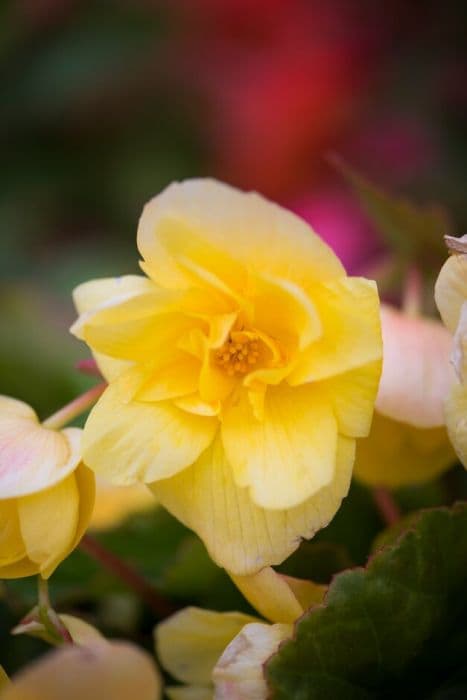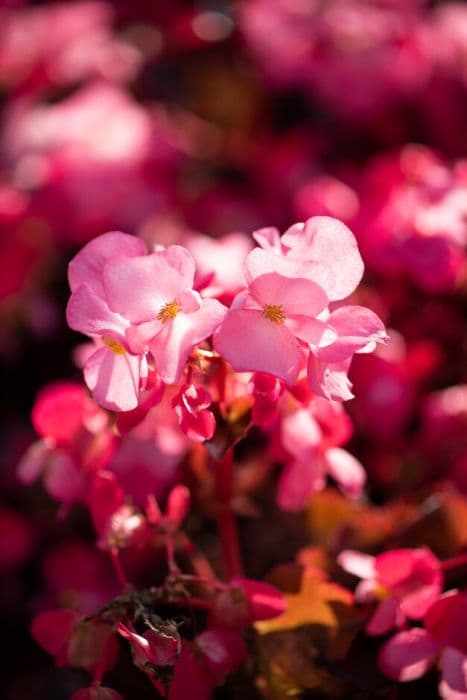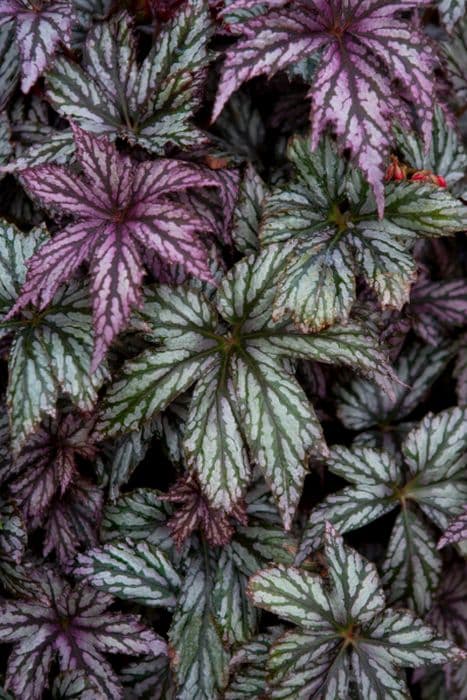Begonia Begonia Sweet Spice Bounty Coral (Sweet Spice Series) (T)
![begonia [Sweet Spice Bounty Coral]](/_next/image?url=https%3A%2F%2Fplants-admin.emdemapps.com%2Fimages%2Fplants%2F%2Fimages%2F604b5eb2df01d.png&w=3840&q=75)
ABOUT
The Begonia Sweet Spice Bounty Coral is a striking ornamental plant known for its vibrant and lush appearance. This begonia boasts a profusion of flowers that are a warm coral hue, often with a delicate, slightly iridescent sheen that catches the light beautifully. The flowers have a full, layered look, reminiscent of classic rose blooms with their plentiful petals that create a rich, textured visual. The foliage of this begonia is equally appealing, with leaves that are typically glossy and display a deep green color. The leaves can sometimes have subtle hints of red or bronze, particularly around the edges or the veins, adding further interest to the plant's appearance. The foliage forms a dense and bushy backdrop to the floral display, creating a full and lush effect. As part of the Sweet Spice Series, this variety may also be noted for the lovely fragrance emitted by the flowers, which adds an additional sensory layer to its appeal. This begonia variety makes a striking addition to any garden or indoor space, providing a touch of vibrant color and a hint of sweet aroma. Overall, the Begonia Sweet Spice Bounty Coral is characterized by its warm coral blooms, glossy green foliage, and pleasing fragrance, making it an attractive choice for both ornamental and sensory gardening experiences.
About this plant
 Names
NamesFamily
Begoniaceae
Synonyms
Sweet Spice Bounty Coral Begonia, Bounty Coral Begonia
Common names
Begonia 'Sweet Spice Bounty Coral'.
 Toxicity
ToxicityTo humans
Begonias, including Begonia 'Sweet Spice Bounty Coral', are considered non-toxic to humans. However, they can cause irritation in the mouth, throat, and may sometimes lead to nausea or vomiting if ingested in large amounts. It's advisable to avoid consuming any part of the plant.
To pets
Begonia 'Sweet Spice Bounty Coral' is toxic to pets, particularly to cats and dogs. If ingested, the plant can cause symptoms such as salivation, vomiting, and difficulty swallowing due to irritation of the mouth and gastrointestinal tract. In severe cases, ingestion might lead to kidney failure. It is important to prevent pets from chewing on or ingesting any part of the plant.
 Characteristics
CharacteristicsLife cycle
Perennials
Foliage type
Evergreen
Color of leaves
Varies
Flower color
Coral
Height
1 foot 2 inches (35 centimeters)
Spread
1 foot 2 inches (35 centimeters)
Plant type
Herb
Hardiness zones
10
Native area
Tropical South America
Benefits
 General Benefits
General Benefits- Aesthetic Appeal: Offers vibrant coral-colored flowers that enhance the beauty of any garden space.
- Long Blooming Period: Produces flowers throughout the growing season, providing consistent color and interest.
- Low Maintenance: Requires minimal care, making it suitable for gardeners of all skill levels.
- Attracts Pollinators: Flowers can attract butterflies and other beneficial insects to the garden.
- Compact Growth: Ideal for small gardens or containers due to its tidy growth habit.
- Versatile Planting Options: Can be used in mixed borders, containers, or as an underplanting for larger shrubs.
 Medical Properties
Medical PropertiesThis plant is not used for medical purposes.
 Air-purifying Qualities
Air-purifying QualitiesThis plant is not specifically known for air purifying qualities.
 Other Uses
Other Uses- Decorative Container Planting: Begonia can be used as an attractive centerpiece for container gardens, adding color and form diversity.
- Floral Arrangements: The vibrant flowers of the Begonia can be cut and added to bouquets for a splash of coral color.
- Bonsai Specimen: With careful pruning and training, certain Begonia varieties can be grown as a bonsai plant.
- Photography Subject: Begonia's unique floral display makes it an excellent subject for botanical photography.
- Crafting: Begonia flowers can be used in crafting, such as pressing for bookmarks or handmade paper.
- Gift Plant: Owing to its beauty and wide appeal, a Begonia plant makes for a thoughtful and appreciated gift.
- Edible Decor: While not common, some Begonias have edible flowers that can adorn food dishes as edible decor.
- Theatrical Props: Due to their lush appearance, Begonia plants can be used as a part of set design in theater productions.
- Living Jewelry: Small segments of Begonia can be incorporated into living jewelry pieces, like pendants.
- Education and Research: Begonia species can be used in educational settings to teach about plant biology, hybridization, and horticulture.
Interesting Facts
 Feng Shui
Feng ShuiThe Begonia is not used in Feng Shui practice.
 Zodiac Sign Compitability
Zodiac Sign CompitabilityThe Begonia is not used in astrology practice.
 Plant Symbolism
Plant Symbolism- Caution: Begonias are often considered a symbol of caution or warning, suggesting to take care or be alert to potential issues.
- Harmony: The balance and beauty of the Begonia Sweet Spice Bounty Coral may symbolize harmony and peaceful existence.
- Gratitude: Begonias can represent deep appreciation and thankfulness, making them suitable for gifts to express gratitude.
- Individuality: With their unique appearance, begonias can symbolize being different and standing out from the crowd.
 Water
WaterThe Begonia 'Sweet Spice Bounty Coral' prefers to have consistently moist soil but it is important not to overwater as this can lead to root rot. Typically, watering should be done when the top inch of the soil feels dry to the touch. Depending on the environment, this might mean watering approximately every 7 to 10 days. When watering, use room temperature water and pour slowly around the base of the plant until water begins to run through the drainage holes, indicating the soil is saturated. In warmer months or drier conditions, this plant might require watering twice a week, while in cooler or more humid conditions, the frequency may decrease. Ensure the pot has adequate drainage to prevent water from gathering at the bottom.
 Light
LightBegonia 'Sweet Spice Bounty Coral' thrives best in bright, indirect light. It can tolerate some morning sun but should be protected from harsh, direct afternoon sunlight which can scorch the leaves. A spot near an east-facing window or a few feet away from a south- or west-facing window is ideal. It's beneficial to rotate the plant occasionally to ensure even growth since this plant will grow towards the light source.
 Temperature
TemperatureBegonia 'Sweet Spice Bounty Coral' prefers temperatures between 60 to 75 degrees Fahrenheit and should not be exposed to temperatures below 50 degrees Fahrenheit as it is not frost tolerant. At sustained temperatures above 75 degrees, the plant may become stressed and require additional attention to watering and humidity. The ideal setting would maintain a steady temperature within this range, avoiding drafts, sudden temperature changes, or proximity to heating and cooling vents.
 Pruning
PruningPruning Begonia 'Sweet Spice Bounty Coral' encourages bushier growth and can help maintain a tidy appearance. Trimming back leggy stems and removing dead or yellowing leaves can be done as needed throughout the year. The best time for heavy pruning is in the spring, just before the new growth begins. Pruning is also a good opportunity to propagate new plants by using the cuttings. Regular deadheading of spent flowers will promote further blooming.
 Cleaning
CleaningAs needed
 Soil
SoilBegonias prefer well-draining soil with a mix of peat, perlite, and compost. A pH of 5.5 to 6.5 is ideal for these plants to thrive.
 Repotting
RepottingBegonias should be repotted every one to two years, or when the roots outgrow the pot, ensuring minimal stress to the plant.
 Humidity & Misting
Humidity & MistingBegonias favor high humidity levels, ideally between 50% and 70%, to maintain their lush foliage and vibrant blooms.
 Suitable locations
Suitable locationsIndoor
Place in bright, indirect light and maintain high humidity for best growth.
Outdoor
Partial shade with protection from harsh sun; moist, well-draining soil.
Hardiness zone
10-11 USDA
 Life cycle
Life cycleThe life cycle of the Begonia Sweet Spice Bounty Coral begins with seed germination, where warmth and humidity are essential. Upon sprouting, seedlings will gradually develop true leaves and can be transplanted into individual pots. As they mature, the plants enter a vegetative stage, producing lush foliage and eventually flowering when they receive ample light and consistent moisture. The flowers will be vibrant and display the characteristic coral hue. After the blooming period, the plant can be encouraged to flower again by deadheading spent blooms and providing well-balanced fertilization. At the end of the growing season, the begonia can enter a dormant period if conditions simulate a cooler and less active winter-like phase, during which it conserves energy for the next growing season.
 Propogation
PropogationPropogation time
Spring to Summer
The Begonia Sweet Spice Bounty Coral, a member of the Sweet Spice Series, is typically propagated through stem cuttings, which is the most popular method. The best time to take stem cuttings for propagation is during the plant's active growth period, typically in the spring or early summer. For propagation, a healthy stem cutting with a few leaves is selected and then cut just below a node. The cut end of the stem should be allowed to callous over for a few hours before being planted in a moist, well-draining potting mix. To provide the cutting with the necessary humidity to root, cover the pot with plastic wrap or place it in a propagator. Roots usually develop within a few weeks, after which the new Begonia plant can be transferred to a permanent pot.



![Begonia [Bonfire]](/_next/image?url=https%3A%2F%2Fplants-admin.emdemapps.com%2Fimages%2Fplants%2F%2Fimages%2F604b6124363f0.png&w=640&q=75)


![Begonia [Devotion]](/_next/image?url=https%3A%2F%2Fplants-admin.emdemapps.com%2Fimages%2Fplants%2F%2Fimages%2F604b58183573b.png&w=640&q=75)


